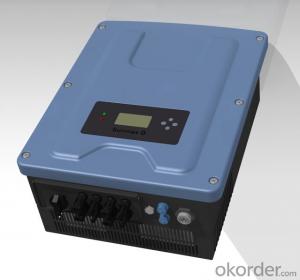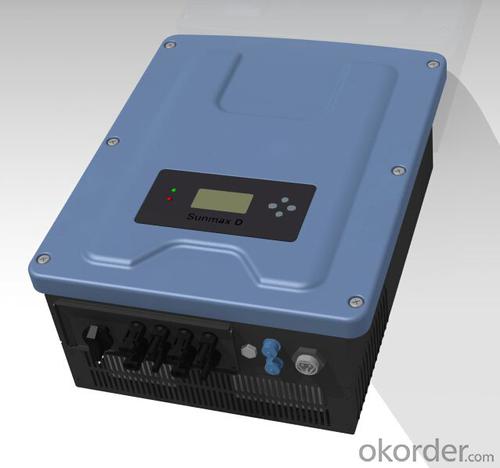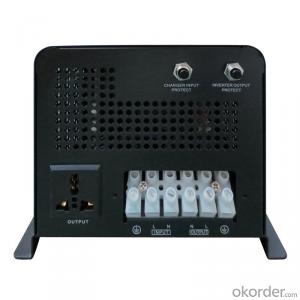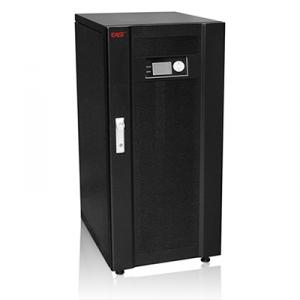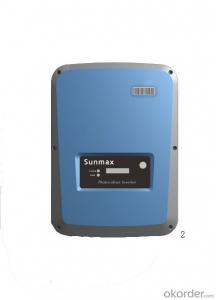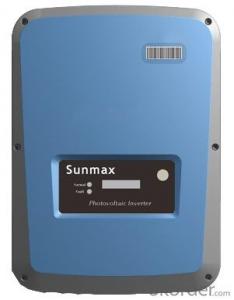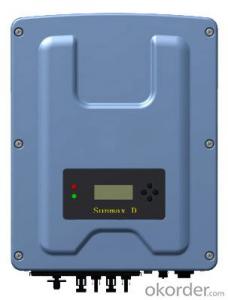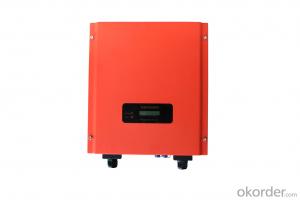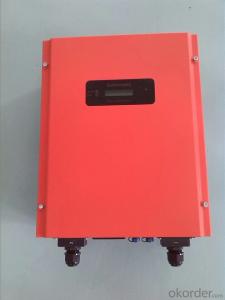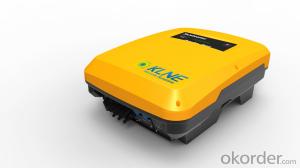Solar Inverter in Nigeria - PV Inverter Sunmax D 3000/4000/5000
- Loading Port:
- Shanghai
- Payment Terms:
- TT OR LC
- Min Order Qty:
- 5 watt
- Supply Capability:
- 3000 watt/month
OKorder Service Pledge
OKorder Financial Service
You Might Also Like
The Sunmax D 3000/4000/5000 series are applicable to rooftop installation and small scale photovoltaic grid-connected power plants. Their rated output powers are 3 kW, 4kW, 5 kW respectively. This series are transformer-less in design and have a wide range of MPPT voltage. Their maximum conversion efficiency and MPPT tracking accuracy reaches 97.6 % and 99.5 % respectively. The maximum DC voltage reaches 580 V. The series have dual MPPT trackers, providing maximum flexibility for solar plants. The series adopts the latest technology, supports reactive power adjustable and meets the VDE-AR-N 4105 standard.
Characteristics:
Dual MPPT with tracking efficiency over 99.9%
Supporting reactive power adjustable
Unit noise less than 30Db
Current harmonic less than 3%
Design features:
Allows access to third party monitoring system: Solar-log, Solar –man, Taoke, etc.
Equipped with active / inactive way to adjust the design instruction
Single / dual MPPT design
IP65 protection class to meet outdoor installation requirements
Transformer-less design
Units have built-in leakage current monitoring devices
Suspension design, installation is simple
Man-machine interface (LCD) in English, Italian, German languages
Man-machine interface (LCD) regulation parameters can be set making installation easy
Total digital design.
- Q: Can a solar inverter be connected to a battery storage system?
- Yes, a solar inverter can be connected to a battery storage system. In fact, this is a common setup in many residential and commercial solar installations. The solar inverter is responsible for converting the direct current (DC) generated by the solar panels into alternating current (AC) that can be used to power electrical appliances. By connecting a battery storage system to the solar inverter, excess energy generated by the solar panels can be stored in the batteries for later use, such as during periods of low sunlight or during power outages. This allows for greater energy independence and the ability to maximize the utilization of solar energy.
- Q: Photovoltaic grid-connected inverter without DC emc how will happen
- can convert light energy into electricity, so that the current flow from one side to the other, the general can be issued equivalent to 10 to 20% of the received light energy. In general, the stronger the light, the more electricity is generated. Its working principle is based on the semiconductor PN junction of the photovoltaic effect. The so-called photodynamic effect is when the object by the light, the object within the charge distribution of the state of the electromotive force and current generated an effect.
- Q: What is the role of a solar inverter in preventing system failures?
- The role of a solar inverter in preventing system failures is to convert the direct current (DC) produced by solar panels into alternating current (AC) that can be used to power electrical devices. By continuously monitoring the performance of the solar system and ensuring the optimal conversion of power, the inverter helps to prevent issues such as voltage fluctuations, overloading, and short circuits. It also provides vital protection by promptly detecting and responding to any faults or abnormalities in the system, thereby minimizing the risk of system failures and maximizing the overall efficiency and reliability of the solar power generation.
- Q: Can a solar inverter be used in a solar-powered telecommunications system?
- Yes, a solar inverter can be used in a solar-powered telecommunications system. The solar inverter is responsible for converting the direct current (DC) produced by solar panels into alternating current (AC) that can be used to power various devices in the system, including telecommunications equipment.
- Q: Can a solar inverter be used in a community solar project?
- Yes, a solar inverter can be used in a community solar project. A solar inverter is an essential component of a community solar project as it converts the direct current (DC) electricity generated by the solar panels into alternating current (AC) electricity, which can be used by the community or fed back into the grid.
- Q: Are all solar inverters compatible with all solar panels?
- No, not all solar inverters are compatible with all solar panels. The compatibility between solar inverters and panels depends on various factors such as the voltage, current, and type of panels being used, as well as the specifications and requirements of the specific inverter model. It is important to ensure that the inverter is compatible with the specific type and configuration of solar panels being installed to ensure optimal performance and efficiency.
- Q: Can a solar inverter be used with a three-phase electrical system?
- Yes, a solar inverter can be used with a three-phase electrical system. In fact, many solar inverters are specifically designed to work with three-phase systems. They convert the direct current (DC) generated by the solar panels into alternating current (AC) that can be used to power three-phase electrical loads.
- Q: How does a three-phase solar inverter differ from a single-phase inverter?
- A three-phase solar inverter differs from a single-phase inverter in terms of the number of electrical phases and the power output capacity. While a single-phase inverter is designed to convert the direct current (DC) generated by solar panels into alternating current (AC) with a single electrical phase, a three-phase inverter converts DC power into AC power with three electrical phases. This allows for a more balanced distribution of power across the three phases, resulting in increased efficiency and higher power output. Additionally, three-phase inverters are commonly used in industrial and commercial settings where higher power demands are required, while single-phase inverters are typically used in residential applications with lower power requirements.
- Q: How does a solar inverter affect the overall energy consumption of a property?
- A solar inverter converts the direct current (DC) generated by solar panels into alternating current (AC) that can be used to power electrical appliances in a property. By efficiently converting DC to AC, a solar inverter enables the property to utilize the renewable energy generated by the solar panels. This reduces the reliance on grid electricity, thereby decreasing the overall energy consumption of the property and leading to potential cost savings on electricity bills.
- Q: How does a solar inverter handle voltage dip and interruption?
- A solar inverter handles voltage dip and interruption by monitoring the grid voltage constantly. When it detects a dip in voltage or an interruption, it quickly switches to an internal power source, such as a battery or capacitors, to keep supplying power to the connected solar panels or loads. This ensures a smooth and uninterrupted power supply even during voltage fluctuations or grid outages.
Send your message to us
Solar Inverter in Nigeria - PV Inverter Sunmax D 3000/4000/5000
- Loading Port:
- Shanghai
- Payment Terms:
- TT OR LC
- Min Order Qty:
- 5 watt
- Supply Capability:
- 3000 watt/month
OKorder Service Pledge
OKorder Financial Service
Similar products
Hot products
Hot Searches
Related keywords
